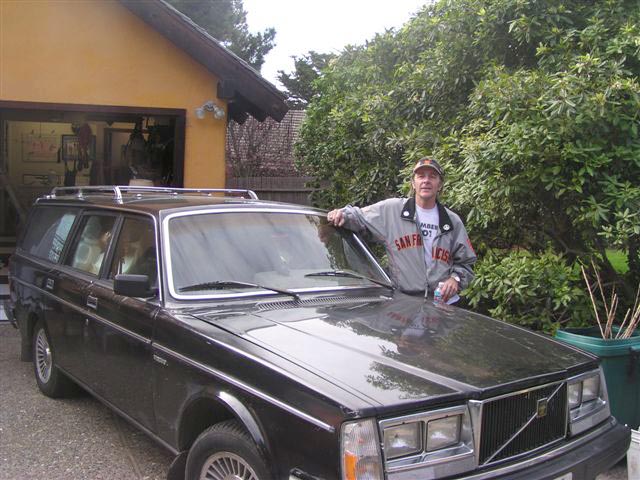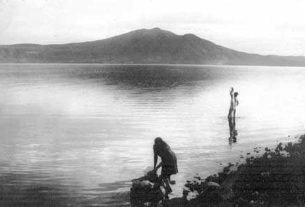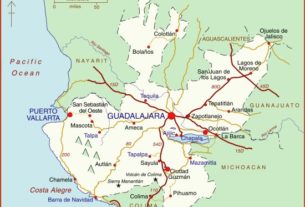Two years ago, I would’ve been leery about driving out of Mexico alone.
Well, “everyone says” that the drive to Nogales (from Puerto Vallarta) is a drag: long, flat, boring, and nothing to see – something like, “straight roads and lots of desert.” As is the usual case with “the CV” (the Conventional Wisdom), it was way off base. The route is varied and interesting with lots of green countryside punctuated by beautiful valleys and vistas, and nice little towns like Tepic, Guaymas and Santa Ana to break up the drive.

I scrubbed down the old Landship (our 1983 Volvo wagon) one more time last month, and headed north at 6 a.m. Easter Sunday. After 24 years of regular rubbing, some of the black paint on the hood had started to fade to brown, but the car still looked good, as long as you didn’t look too closely. However everything not made of metal seemed to be falling off lately, and some metal parts as well. We hated to let go of the Landship. It felt sort of like putting down a sick old pet. But Volvo parts are hard to come by in Vallarta, and the breakdowns were becoming more frequent, so we decided to get it out of Mexico while the gettin’ was good. The car was too old to nationalize and too expensive to junk down here on a Banjercito permit. And besides, we had a newer (1988!) car in storage up north, just waiting to be driven across the border. Also, this presented an opportunity for a road trip. If I do say so meself, there’s hardly anything I’m better at than getting behind the wheel of a car with lots of time and a wallet full of plastic.
Two years ago, I would’ve been leery about driving out of Mexico alone, but now that I’ve mastered lame restaurant Spanish and have a sense of how things work down here (and they always seem to work out), my primary worry was squeezing one more big trip out of the old car. I mostly stuck to the libramientos rather than the cuotas (toll roads), since I had plenty of time and wanted to see the sights. I knew I’d be driving back with friends on the cuotas. Just like on the last long drive in the Landship (down Baja in 2006), the roads proved to be good as long as you stayed between the lines. It’s a fact that the shoulders are often nonexistent or precipitously steep in a lot of places, so that you really have to concentrate on the two-lane roads. If your tire catches on the edge you could wind up in a wrestling match with your steering wheel.
Because rooms were hard to come by over Easter, I had reserved in advance in Mazatlán, and pulled into Margaritas Hotel and Tennis Club on the main drag across from the beach, around 1 p.m. It’s a nice clean hotel (almost $100 U.S. with taxes), but I really should’ve kept driving since I still had half a day of light left. Oh, well, the hardest stretch was past – negotiating the three twisting passes between Vallarta and Mazatlán – and the hotel boasted a guarded parking lot. I used a beer can and half a roll of duct tape to patch the hole in the rear muffler (compliments of the giant topes on our home street), took a nap by the pool, walked the beach, and drove the oceanfront into the old part of Mazatlán. It felt like more of a real Mexican town than the center of Puerto Vallarta, its central plaza full of locals listening to music and a beautiful old iglesia holding an evening Easter service. But I didn’t stay long, dressed in shorts and a tank top. I hadn’t seen Mazatlán for some 25 years, so it was interesting to walk around and revisit the malecón and centro histórico. The city’s Pacific Ocean waterfront runs for miles and has beautiful beaches, but something about it reminds me of junky towns in Florida that cram buildings along the ocean and then let everything else go, as if your eyes could only turn in one direction. Daytona Beach, Mexico.
I got up the next morning in the dark, thinking another early start would beat the remaining Semana Santa traffic, and headed north 200 clicks toward Culiacán. You know, the CV says “Culiacán’s in Sinaloa – it’s dangerous!” no doubt full of carjackers and coked-out dealers. But when I rolled through it looked like a perfectly fine, bustling city on a river, with well-marked roads directing me north. It seemed as if it took forever for the sun to rise, and that I had reached town awfully early. Then I realized I hadn’t changed my watch to Mountain Time, and had hit the road around 4:30 am. This put me in a bit of a bind, because I’d booked a Travelodge in Ciudad Obregón, approximately halfway to Nogales, but only 500 or so clicks farther up Highway 15. Well, the roads were relatively clear of trucks and buses, so I refilled the Landship and pointed her north. When I hit C.O. at noon (another large, nicely laid out city surrounded by fields and orchards), I cancelled the room and kept right on going.
It was sinking in that this was not the onerous drive I’d been warned about, and I began to wonder just how far I could get that day. I wasn’t worried about where to stay, since every city I’d been through had plenty of motels with enclosed parking, including some of the cheesy chains common up north. So I got into a driving kind of mode. Now I’m not recommending this, but sometimes after you’ve been driving for a few hours the wheel and stickshift become extensions of your hands, the pedals part of your feet, and the towns and miles (kilometers) start to fly by. Almost before I knew it I’d gone 200+ clicks to Los Mochis, another 200+ to Guaymas, and when I saw a sign that read “Nogales, 525 km” I knew I’d be sleeping on U.S. soil that night. To reach the border by nightfall I got on the cuotas and flew up through the Sonoran Desert, bypassing Hermosillo and through the pretty little towns of Santa Ana and Magdalena, down a beautiful green river valley to Nogales. (It’s amazing how much greener northern Mexico is than southern Arizona.)
The Mexican side of the Nogales crossing was a breeze. A friendly young woman removed the Banjercito sticker from the windshield and gave me that critical receipt that would allow me to bring the other car back south, and the Landship returned to its native soil. Or so I thought. That was before I ran into the one-lane, three-hour line of cars snaking their way down to the U.S. port of entry. There was nothing to do while I waited in line with the engine off but sneak a beer, smoke a stogie, and make some calls on Telcel while it still worked.
I have to say the INS “service” on our side of the border left something to be desired. I should’ve known things would not go well when one of their robotic young men walked down the line and tapped on the fenders of the Landship as I sat in line. When a stony-faced woman at the booth asked me if I had Cuban cigars, I showed her my cheap American “Backwoods” stogies, and all she said was, “Pull over to space number 3,” as she slapped my passport under the wiper blade. Oh yes, she also said “That document means nothing to me!” when I mistakenly offered her my FM-3. Nice folks. I shivered by the car in the dark while a squad of our finest went over under and through the car with mirrors and fine-toothed combs. I’m not dumb enough to cross a border with contraband, but I must admit I was terrified. And for hours afterward, driving through Tucson and Phoenix, I got nervous whenever I saw flashing bubble-gum lights on a car. The next day I went through a mandatory “police inspection” at Hoover Dam, and it occurred to me what a police state America has become: more and more resembling the stereotype of Mexico, except no one ever smiles.
Postscript
We followed the same route on the drive back a week later, taking the cuotas to save time. They were superior for the most part, except for mysterious construction work north and south of Mazatlán, which seemed to kick us off right after we paid a toll. (Although I didn’t pay them all, I estimated that the total tolls came to around $75 U.S.) The Mexican border officials were all helpful and friendly. On the return, we stayed in the Araiza Hotel in Hermosillo, ($85 plus tax for three, and a very nice property); the following night we paid $75 plus for a real dump in Los Mochis, the El Dorado. In between we stopped for lunch in Guaymas, a very interesting little port on the Sea of Cortes with a vibrant centro and a Southern California beach-town feel. Walked around Los Mochis the following morning and it seemed very beat by comparison: even the local church seemed run-down and lifeless, on Sunday. However, we did find dinner at one of the best street taco stands ever, “Barajas,” well-lit stainless steel counters with a ventilator fan (!), serving arrachera, “vampiros,” and other fare that made the stopover in Los Mochis almost worth it. The next day we finished the drive south, back to Mazatlán and through Tepic, which looked very tidy, with long narrow streets, little parks, and high sidewalks with color-coded buildings. As with the earlier trip, the toughest stretches were the passes north and south of Tepic, but the incredible vistas made up for it, and we happily rolled into Puerto Vallarta just as night fell. Now I’ve got a brand new old car in Mexico, just waiting for the next road trip.



